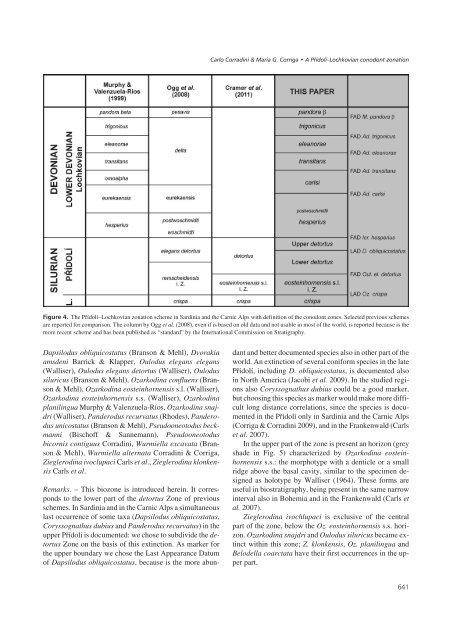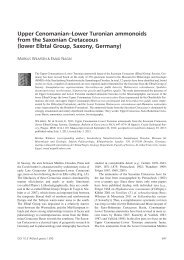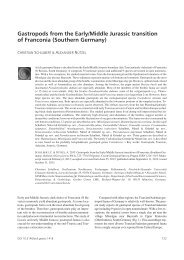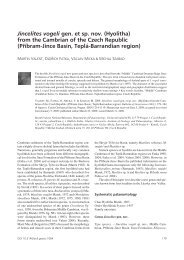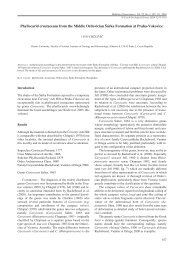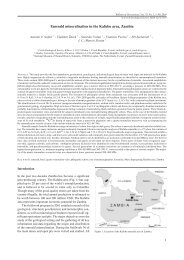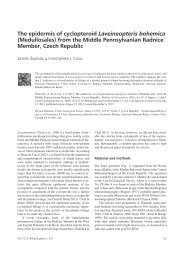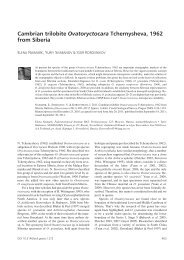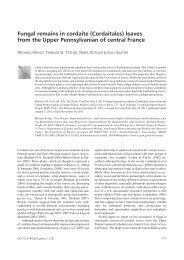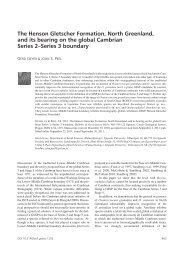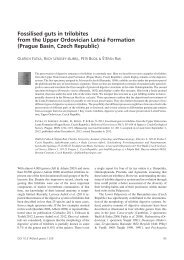full text (PDF, 1.71 MB)
full text (PDF, 1.71 MB)
full text (PDF, 1.71 MB)
You also want an ePaper? Increase the reach of your titles
YUMPU automatically turns print PDFs into web optimized ePapers that Google loves.
The Přídolí–Lochkovian zonation scheme in Sardinia and the Carnic Alps with definition of the conodont zones. Selected previous schemes<br />
are reported for comparison. The column by Ogg et al. (2008), even if is based on old data and not usable in most of the world, is reported because is the<br />
more recent scheme and has been published as “standard” by the International Commission on Stratigraphy.<br />
Dapsilodus obliquicostatus (Branson & Mehl), Dvorakia<br />
amsdeni Barrick & Klapper, Oulodus elegans elegans<br />
(Walliser), Oulodus elegans detortus (Walliser), Oulodus<br />
siluricus (Branson & Mehl), Ozarkodina confluens (Branson<br />
& Mehl), Ozarkodina eosteinhornensis s.l. (Walliser),<br />
Ozarkodina eosteinhornensis s.s. (Walliser), Ozarkodina<br />
planilingua Murphy & Valenzuela-Ríos, Ozarkodina snajdri<br />
(Walliser), Panderodus recurvatus (Rhodes), Panderodus<br />
unicostatus (Branson & Mehl), Pseudooneotodus beckmanni<br />
(Bischoff & Sannemann), Pseudooneotodus<br />
bicornis contiguus Corradini, Wurmiella excavata (Branson<br />
& Mehl), Wurmiella alternata Corradini & Corriga,<br />
Zieglerodina ivoclupaci Carls et al., Zieglerodina klonkensis<br />
Carls et al.<br />
Remarks. – This biozone is introduced herein. It corresponds<br />
to the lower part of the detortus Zone of previous<br />
schemes. In Sardinia and in the Carnic Alps a simultaneous<br />
last occurrence of some taxa (Dapsilodus obliquicostatus,<br />
Coryssognathus dubius and Panderodus recurvatus)inthe<br />
upper Přídolí is documented: we chose to subdivide the detortus<br />
Zone on the basis of this extinction. As marker for<br />
the upper boundary we chose the Last Appearance Datum<br />
of Dapsilodus obliquicostatus, because is the more abundant<br />
and better documented species also in other part of the<br />
world. An extinction of several coniform species in the late<br />
Přídolí, including D. obliquicostatus, is documented also<br />
in North America (Jacobi et al. 2009). In the studied regions<br />
also Coryssognathus dubius could be a good marker,<br />
but choosing this species as marker would make more difficult<br />
long distance correlations, since the species is documented<br />
in the Přídolí only in Sardinia and the Carnic Alps<br />
(Corriga & Corradini 2009), and in the Frankenwald (Carls<br />
et al. 2007).<br />
In the upper part of the zone is present an horizon (grey<br />
shade in Fig. 5) characterized by Ozarkodina eosteinhornensis<br />
s.s.: the morphotype with a denticle or a small<br />
ridge above the basal cavity, similar to the specimen designed<br />
as holotype by Walliser (1964). These forms are<br />
useful in biostratigraphy, being present in the same narrow<br />
interval also in Bohemia and in the Frankenwald (Carls et<br />
al. 2007).<br />
Zieglerodina ivochlupaci is exclusive of the central<br />
part of the zone, below the Oz. eosteinhornensis s.s. horizon.<br />
Ozarkodina snajdri and Oulodus siluricus became extinct<br />
within this zone; Z. klonkensis, Oz. planilingua and<br />
Belodella coarctata have their first occurrences in the upper<br />
part.


